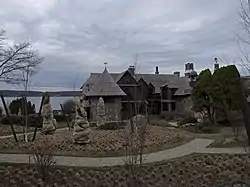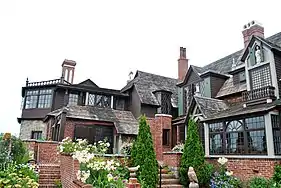Beauport | |
 Beauport | |
  | |
| Location | 75 Eastern Point Boulevard, Gloucester, Massachusetts |
|---|---|
| Coordinates | 42°35′28″N 70°39′38″W / 42.59111°N 70.66056°W |
| Area | .75-acre (3,000 m2)[1] |
| Built | 1907 |
| Built by | Henry Davis Sleeper |
| Architect | Halfdan M. Hanson |
| Architectural style | Shingle Style |
| NRHP reference No. | 03000641, 76000246 |
| Significant dates | |
| Added to NRHP | April 26, 1976[2] |
| Designated NHL | May 27, 2003[3] |
Beauport, also known as Sleeper–McCann House, Little Beauport, or Henry Davis Sleeper House, is a historic house in Gloucester, Massachusetts, USA.
Background
Beauport was built starting in 1908 as the summer home of interior decorator and antique collector Henry Davis Sleeper. Situated on the rocks overlooking Gloucester Harbor, Sleeper repeatedly enlarged and modified the structure, and filled it with a large collection of fine art, folk art, architectural artifacts, and other collectible materials. He decorated its rooms, which came to number 56, to evoke different historical and literary themes. Beauport served as his escape, a backdrop for summer parties, and as a showcase for his professional skills.
After Sleeper's death, Charles and Helena Woolworth McCann acquired the house and its contents. They preserved much of Sleeper's designs and decorations, but made some modifications, including adding their porcelain collection to the house. In 1947, their heirs donated the property to the Society for the Protection of New England Antiquities (now Historic New England), which operates the property as a house museum.[1]
The house has frequently been written about in books and magazines, with the first major article appearing in House Beautiful in 1916. It has been featured in publications including Architectural Digest, Country Living, and The Boston Globe, and has been showcased on television programs such as America's Castles.[1]
Preservation
Beauport was declared a National Historic Landmark in 2003, in recognition of its distinctive architecture, its unique collection of artifacts, and for its association for Sleeper, whose design influence extended across the wealthy elite of the eastern United States.[1][3]
In addition to the main house, the property also has a gate house, garage, and toolshed that were built by Sleeper. The gate house has been adapted by Historic New England as a visitor reception area, and the toolshed now houses restrooms.1 The garage is used for storage and as office space. There is a single non-contributing building on the property, a caretaker's house, which is potentially of local historic interest as an example of a prefabricated post-World War II residential structure.[1]
Gallery
 Beauport, 2016
Beauport, 2016_at_Beauport%252C_Sleeper-McCann_House.jpg.webp) Paul Revere Room (Chapel Chamber), Beauport, Sleeper–McCann House, 1928
Paul Revere Room (Chapel Chamber), Beauport, Sleeper–McCann House, 1928 Amethyst Glass passage, Beauport, Sleeper–McCann House, 1928
Amethyst Glass passage, Beauport, Sleeper–McCann House, 1928 Octagon Room, Beauport, Sleeper–McCann House, 1928
Octagon Room, Beauport, Sleeper–McCann House, 1928 China Trade Room, Beauport, Sleeper–McCann House, 1928
China Trade Room, Beauport, Sleeper–McCann House, 1928 Pine Kitchen, Beauport, Sleeper–McCann House, 1928
Pine Kitchen, Beauport, Sleeper–McCann House, 1928
External links
See also
![]() Media related to Beauport, Gloucester at Wikimedia Commons
Media related to Beauport, Gloucester at Wikimedia Commons
References
- Notes
- 1 2 3 4 5 Timothy T. Orwig, Carolyn Pitts, and Patty Henry (2001-08-31) National Historic Landmark Nomination: Beauport / Sleeper–McCann House; Little Beauport; Sleeper, Henry Davis, House, National Park Service (including maps and plans and Accompanying nine photos, exterior and interior, from 1977, 1979, 1980s, 1994
- ↑ "National Register Information System". National Register of Historic Places. National Park Service. January 23, 2007.
- 1 2 "Beauport". National Historic Landmark summary listing. National Park Service. Archived from the original on June 6, 2009. Retrieved July 12, 2008.
- Bibliography
- Shoemaker, L. "Backstage at Beauport: SPNEA shines a spotlight on the extended family who made the house work." Historic New England, Summer 2004.
